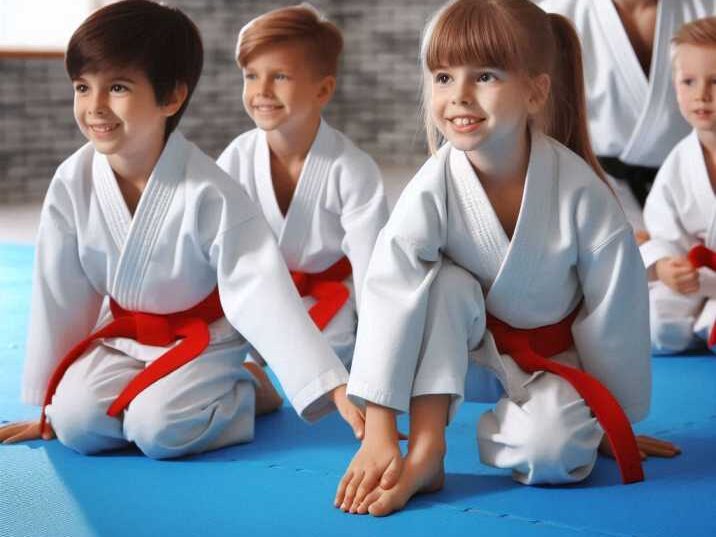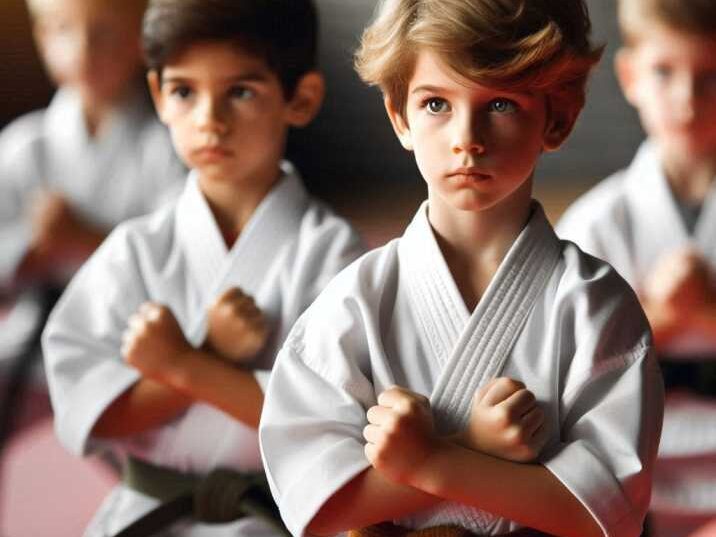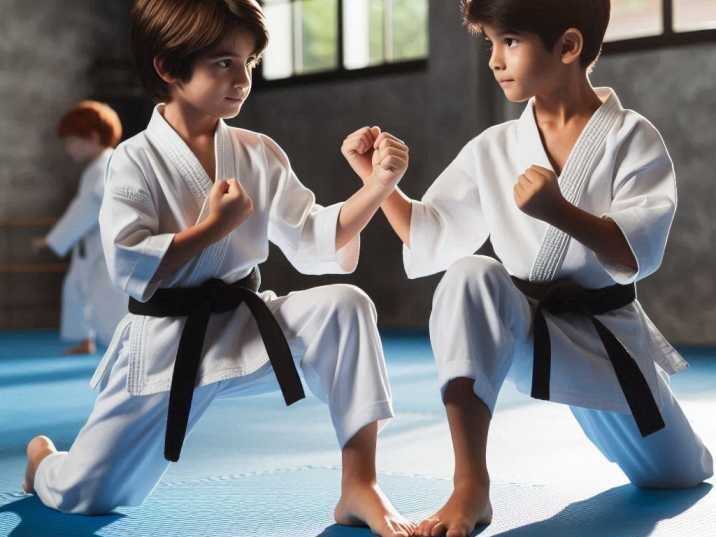Martial arts and fighting may look the same to some people, especially in movies or TV shows. But they are actually very different! This article will help you understand what sets them apart in a fun and simple way. We will also talk about how training in martial arts can help kids focus better in school and life.
Introduction: Two Words, Two Worlds
Table of Contents
When people see two individuals sparring or battling, they might call it a fight. But if you take a closer look, you’ll notice there is more to martial arts than just hitting or kicking. It is an ancient practice that teaches discipline, respect, and self-control.
On the other hand, fighting usually means using force or violence to hurt someone, often without rules or training. Fighting is often uncontrolled and can be dangerous.
Let’s explore the main differences between martial arts and fighting, and why knowing this is important.
The Meaning of Martial Arts
A System of Training
Martial arts are organized systems of combat training. They teach students how to defend themselves, stay fit, and grow as people.
Common Styles
Some popular types of martial arts include:
Karate (from Japan)
Karate is a martial art that focuses on punches, kicks, and strong blocks. It teaches students to move with speed and power. Students learn kata (patterns) to improve their skills. Karate also helps build discipline and respect for others.
Taekwondo (from Korea)
Taekwondo is known for its high and fast kicks. It teaches students how to use their legs with strength and precision. This martial art also includes forms and sparring. Many kids love Taekwondo because it improves balance and flexibility.
Kung Fu (from China)
Kung Fu includes many styles based on animals like tigers and snakes. It combines strong movements with smooth, flowing motions. Kung Fu also focuses on meditation and breathing. It helps kids learn self-control and calmness.
Judo and Brazilian Jiu-Jitsu (grappling styles)
Judo and Brazilian Jiu-Jitsu teach students how to wrestle and control an opponent using throws and holds. These styles focus on technique over strength. Instead of hitting, they use grips and ground moves to win safely. These arts are great for building confidence and patience.

Muay Thai (from Thailand)
Muay Thai is called the “Art of Eight Limbs” because it uses hands, elbows, knees, and feet. It teaches powerful strikes and clinch fighting. Muay Thai also builds endurance and toughness. It’s often used in professional fights but also taught with safety in mind.
Each style focuses on specific movements like punching, kicking, or throwing.
The Nature of Fighting
Raw and Untrained
Fighting is usually what happens when people get angry or want to win a personal argument. There is no structured form or teacher. It can be dangerous and even illegal.
Not a Sport
Fighting on the street or in anger doesn’t follow rules. People can get hurt badly. That’s why schools and parents always teach kids to avoid fights.
How Martial Arts Helps Kids
Improves Focus
Martial arts training helps kids stay focused and pay attention. They have to listen carefully to their instructor and remember each move. This skill carries over to schoolwork and homework. Better focus means better learning and success!
Builds Confidence
When kids earn a new belt or break a board, they feel proud of what they’ve done. Martial arts build self-confidence by showing kids they can achieve goals through hard work. Each small win helps them believe in themselves more.
Teaches Respect
In martial arts, kids bow to instructors and teammates to show respect. They learn to treat others kindly and follow the rules. Even when sparring, they stay polite and friendly. Respect becomes part of their everyday life.
Encourages a Healthy Lifestyle
Martial arts classes are a fun way to exercise and stay active. Kicking, punching, and stretching help improve fitness, strength, and balance. It’s a great way for kids to stay healthy while having fun at the same time.
Self-Control vs. Aggression
Martial arts teach kids to stay calm, not angry, even in tough situations. They learn to think before acting and control their emotions. Fighting, on the other hand, is often based on anger or revenge, which is not healthy or safe.
Guided Practice vs. Random Action
In a martial arts class, every move is part of a planned lesson. Students practice with drills, forms, and sparring, learning step by step. Fighting is random and messy, with no guidance or warm-up. That’s why training is safer and smarter.
Safety First
Martial artists wear safety gear like gloves, helmets, and pads. Instructors teach them how to train without getting hurt. Fighting in the street can cause serious injuries. Martial arts are about safety, not danger.
Why Parents Prefer Martial Arts Over Fighting
- Promotes discipline
- Reduces bullying
- Improves academic performance
- Enhances social skills
- Teaches peaceful conflict resolution
Stand Up to Bullies the Right Way
Martial arts teach kids how to be strong and peaceful. Instead of fighting, they learn to use words and confidence to handle bullies. Knowing how to protect yourself gives you the courage to walk away or ask for help. It’s all about being smart, not violent.
Stay Calm During Problems
When things get tough, martial artists stay calm. They learn to breathe deeply and think before acting. This helps them solve problems without yelling or getting upset. It’s like having a cool mind in a hot situation!
Focus Better in Class
Martial arts improve concentration and listening skills. Kids practice paying close attention during training, which carries over to school. This means they do better on tests, finish homework faster, and follow directions more easily.
Stay Healthy and Active
Punches, kicks, stretches, and jumps are all part of martial arts. It’s a fun way for kids to get exercise and stay in shape. Staying active helps them feel happy, strong, and full of energy all day long!

Real Facts & Figures
Better Behavior in School
The American Academy of Pediatrics says that kids who do martial arts often have better behavior. They learn respect, discipline, and how to follow rules. This makes them more focused and respectful in the classroom
Improved Mental Health & Self-Esteem
A study in the Journal of Sport and Health Science found that martial arts can boost mental health and self-esteem. Kids feel proud when they learn new moves and earn belts. Feeling good about themselves helps them feel happier every day.
Millions of Kids Train Every Year
According to Statista (2023), more than 3.6 million kids in the U.S. take martial arts classes each year. That’s because parents trust it to build strength, respect, and confidence in their children. Martial arts is growing fast across the country!
Table: Key Differences Between Martial Arts and Fighting
| Feature | Martial Arts | Fighting |
|---|---|---|
| Purpose | Self-defense, fitness, discipline | Hurting others or winning a conflict |
| Training | Formal, with rules and techniques | Often no training or structure |
| Discipline | High level of mental and physical control | Little to no discipline |
| Teachers/Instructors | Taught by certified professionals | Usually self-taught or no training |
| Setting | Dojos, gyms, schools | Streets, schoolyards, informal places |
| Respect and Rules | Core values | Often ignored |
| End Goal | Self-improvement and peace | Domination or harm |

Conclusion: Choose Martial Arts, Not Fighting
While fighting is wild and harmful, martial arts are thoughtful and helpful. They teach respect, discipline, and control. Martial arts help you become stronger in body and mind. So next time you think of fighting, remember there’s a better way — train instead!
FAQs
1. Is martial arts the same as fighting?
No. Martial arts are trained skills with discipline, while fighting is often emotional and untrained.
2. Can martial arts stop bullying?
Yes, martial arts help kids stand up for themselves in non-violent ways.
3. Are all martial arts the same?
No. There are many styles like Karate, Judo, and Taekwondo, each with unique moves.
4. Can martial arts help with school focus?
Yes. Martial arts training improves attention span and discipline.
5. Is fighting illegal?
Yes, fighting in public can lead to punishment or trouble with school and the law.


